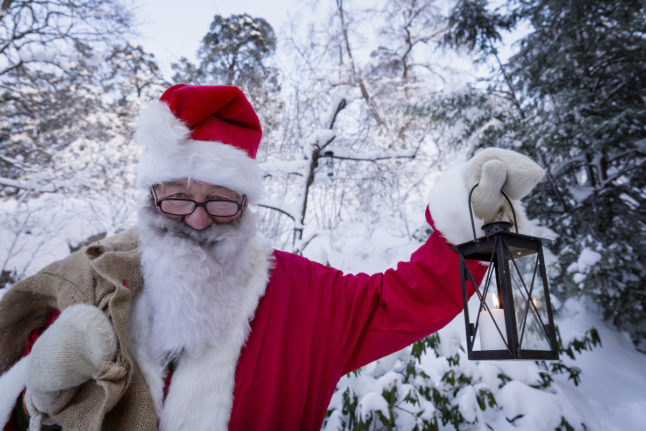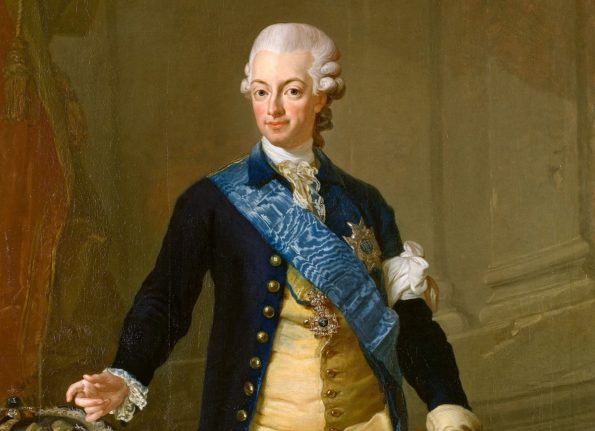“Nu är det jul igen,” they all sing (“now it’s Christmas again”). You’ve been through both Advent and Lucia and finally, it’s Christmas Eve. So what exactly happens in Sweden?
Julbord
The renowned Swedish tradition of the smörgåsbord transforms at Christmas time into the Julbord – literally Christmas table. The julbord is essentially a buffet of bizarre and beautiful seasonal Swedish delicacies.
These include the basics like Swedish meatballs, but often also jellied pigs’ feet, Vienna sausages (known as prinskorv, prince sausages in Swedish), gravad lax – raw salmon cured in dill and lemon, and a traditional dish called Jansson’s Temptation – a creamy potato casserole with anchovies. Pâtés of liver and seafood are also popular.
If you’re doing it properly, help yourself to cold dishes first, and then return for the warm food. You’re supposed to eat everything in the right order, so stay near a Swedish friend who will see you right.
A favourite traditional dessert following the julbord is rice porridge with cinnamon, sugar, and milk. Any sort of dessert using figs, such as fig parfait or ice cream or simply frozen or gratinated figs, is also popular.
The julbord is, of course, accompanied by snaps and aquavit – but not wine. While a small cup of glögg might be had before the buffet begins, wine with Christmas food is a rookie foreigner mistake.
READ ALSO: An idiot’s guide to a Swedish julbord
Glögg
If you’re puzzling over how to pronounce this one, you’re not alone. But this is essentially a delicious spiced drink which simply tastes like Christmas. One could say that glögg is the sound you make as you gulp down another glass.
In all practicality, however, glögg is not something one chugs. The traditional warm mulled wine is served in miniature cups and is sipped slowly. Most Swedes add blanched peeled almonds and raisins to their cups.
Bottles of glögg can be purchased in low and no-alcohol varieties at any food market during winter, though for the more full-bodied versions you’ll have to head to liquor monopoly Systembolaget. The drink can also be prepared at home. Glögg is made from red wine and spices such as cardamom, cloves, and cinnamon.
READ ALSO: How to make your own Swedish glögg
Tomte
During the last couple of decades the Swedish Tomte has gone through a bit of an identity crisis. These days, he’s the same jolly round man known as Santa Claus in the USA, but originally the Tomte was a gnome – a short, wrinkly-faced mischievous man with roots in Norse paganism.
The Tomte was said to live beneath the floorboards of houses or barns, and protected livestock. He is associated with another Swedish Christmas symbol, a goat (julbock). These days perhaps the most famous incarnation is the Gävle Goat, a giant straw goat which is frequently the victim of arson as Christmas approaches.
Several traditional Swedish Christmas songs mention the tomte – including one little ditty the Swedes love to sing as a drinking song before a julbord, “Hej Tomtegubbar”.
Roughly translated the key phrase is “Hey, jolly gnomes, fill your glasses and let’s be merry together. We only live on this earth for a short while with a lot of toil and trouble.” That’s a Merry Swedish Christmas for you. If you’re going to be in Sweden over Christmas, learn this song. It’s simply easier that way.
READ ALSO: Introducing the Swedish Christmas Tomte
The Tree
Swedes have a penchant for dancing in circles around tall objects. During Midsummer they orbit around the Maypole; at Christmas, the Christmas tree. But the idea is the same. Eat, drink, be merry, and sing songs about funny little frogs as you dance around something tall and green.
The Christmas tree itself is decorated, much like in many other parts of the world – but isn’t as glittery as in some countries. While many Swedes do use glass ball ornaments as well nowadays, most still use primarily traditional ornaments made of straw, in the shapes of stars, angels, pinecones, and goats. Gingerbread cookies and paper hearts also make appearances.
Donald Duck
You thought your Swedish mates were going to put on It’s a Wonderful Life this Christmas like the Americans do? Think again. It’s time for Donald Duck.
Disney’s dorky and mildly devilish duck, known as Kalle Anka in Swedish, rules Christmas TV. Christmas celebrations are organised around the figure, we kid you not. Swedes adore the duck. The Disney Christmas special, From All of us to All of You, known in Swedish as Kalle Anka och hans vänner önskar God Jul (“Donald Duck and His Friends Wish You a Merry Christmas”), is shown at 3pm every year on Christmas Eve. Every year. Don’t even think about recording it to watch later.
While Donald gets all the credit, the show in fact features a whole range of classic Disney characters, from Snow White to Mickey Mouse, as well as the eponymous duck. The show was first aired in 1959, and it’s been a tradition ever since. Each time the show, or even one portion of it has been threatened by broadcasters, the public response has been strong enough to restore it. In other words: It’s an oldie, it’s a goodie, and you can’t touch it.
Another Christmas television favourite is Sagan om Karl-Bertil Jonssons Julafton by Per Åhlin, from the short story by Tage Danielsson. Made in 1975, the animated movie follows a Robin Hood style theme where wealthy Stockholmers are robbed and the bounty given to the poor.
The Christmas Calendar
A Christmas TV tradition dating back to 1960. The Christmas Calendar, known until 1971 as the Advent Calendar, is a yearly TV series airing one episode each day in December, culminating on Christmas Eve. The show is always aired on Swedish Television (SVT).
Julmust
Devised by Harry and Robert Roberts in 1910 as an alcohol-free alternative to beer, Julmust, which is somewhat like a super sweet, spiced root beer, makes up more than 75 percent of drink sales in December, by far outselling Coca Cola, which is usually the most popular drink.
The syrup used in the drink is still made exclusively by the Roberts family in Örebro, though the syrup is then sold to various manufacturers who make the final product their own way. The recipe contains hops, sugar, malt aroma and spices.
The same drink is sold at Easter under a different name, påskmust, but is otherwise unavailable the rest of the year.
God Jul from The Local to all our readers!



 Please whitelist us to continue reading.
Please whitelist us to continue reading.
Also, I just found out about “Bingolotto” on Uppesittarkväll, this year. Maybe The Local can write about that for next year. At least for some folks, I guess it’s a pretty big deal/something they do *every* year :).